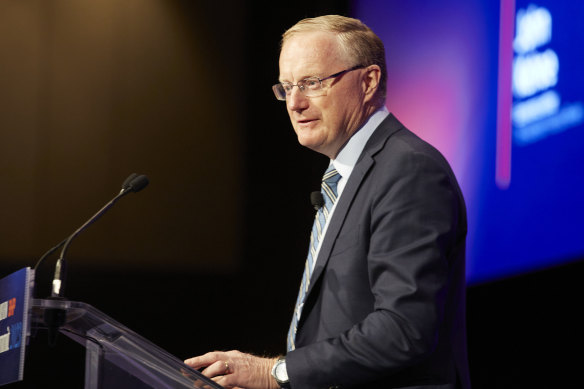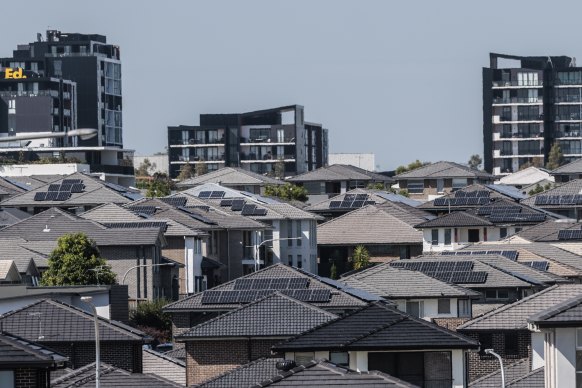
Why Lowe showing his softer side won’t change his inflation resolve
Reserve Bank governor Philip Lowe used his appearance at a business conference to provide an inkling into his softer side – explaining that the pain experienced by those financially struggling “weighed heavily” on his heart.
Lowe plans to meet suicide prevention agencies including Lifeline, to get an uncomfortable firsthand look at the effects extreme financial stress can have on parts of the community.
Steely resolve: Reserve Bank governor Philip Lowe.
While the pain of 10 rate rises for some borrowers may be keeping Lowe and the RBA board up at night, it will not be enough to break the central bank’s steely resolve that its greater responsibility is to tame inflation.
Providing some evidence of his compassionate side appears to be in response to the growing community chorus of RBA detractors, who portray him as a heartless, out of touch, machine-like economist who only understands data.
But the greater good for the economy will still trump the hardship felt by a growing group of struggling individuals. Lowe won’t be distracted from his mission to get inflation back to its target.
So his critics are correct in part. How Lowe and the RBA move on rates in the coming months will be determined by the numbers. The central bank will want to see the job market cooling, wages growth avoiding a break-out and consumer demand continuing to ease.
Lowe won’t be distracted from his mission to get inflation back to its target.
These will be the pre-conditions for any reprieve from higher rates.
But the RBA will also be more alert to the risk that a tougher push on rates risks sending the economy into recession.
Tuesday’s RBA statement on monetary policy is now being dissected by markets and economists for hints on how it sees the trajectory and timing of rate movements.
Before Tuesday’s decision, the RBA had made it clear that there would be at least two more rate rises this year.
The slightly softer stance the RBA delivered on Tuesday, and Lowe’s hints on Wednesday at The Australian Financial Review business summit that the end of the tightening cycle is in sight, provide a glimmer of hope that there might be only one more quarter percentage point rise before there is a pause.
That said, there remain plenty of experts predicting another two rate rises for the remainder of this year.
And a pause in rate increases doesn’t necessarily translate to the end of the rate rising cycle. It could just be a breather to let the RBA see the effects the first 10 rises are having on jobs and spending and the overall economy.
Household debt as a share of income is now 188 per cent, pushing some into financial crisis.Credit:Brook Mitchell
Already mortgage repayments as a proportion of household income are close to record levels. While the current interest rate is at nowhere near the level it has been in the past, household balance sheets today are in a much more precarious state.
Plus the speed of the rate rises is testing records.
The 350 basis point increase in the cash rate over the eleven months since rate rises started in May now clearly surpasses all the rate rising cycles seen since 1990. It’s the fastest tightening since the rise from 10.6 per cent to 18.2 per cent between January 1988 and November 1989, according to AMP chief economist Shane Oliver.
Of course, household debt as a share of income was only 68 per cent then, whereas it’s now 188 per cent, so rates shouldn’t have to go up anywhere near as much as they did in the 1980s to slow spending and hence inflation, says Oliver.
As a nation that mostly borrows on variable rates, our finances are particularly sensitive to movements in rates.
Both Oliver and the economists at Deloitte are among a growing band of experts calling for the RBA to hold off on further rate rises.
The RBA’s latest increase – done despite the fact that inflation and the economy are slowing – brings the cash rate to 3.6 per cent, placing further cost of living pressures on Australians while increasing the chance of an unnecessary recession, said Pradeep Philip, head of Deloitte Access Economics.
Oliver argued “the impact on the key 25 to 45-year-old household demographic from rate hikes and cost of living pressures is now horrendous”.
“Put simply, household debt servicing payments are now pushing their highest level in more than a decade, and a rise in the cash rate to 4.1 per cent as many are forecasting will take household debt servicing payments to a record level in terms of household disposable income.”
The RBA may not be swayed by a visit to Lifeline, but the opinions of respected economists are hard to ignore.
The Market Recap newsletter is a wrap of the day’s trading. Get it each weekday afternoon.
Most Viewed in Business
From our partners
Source: Read Full Article

